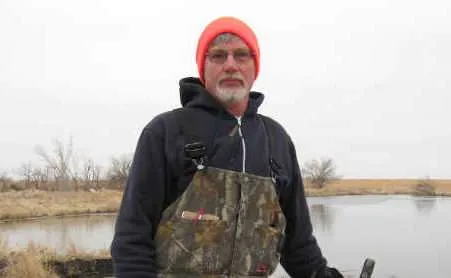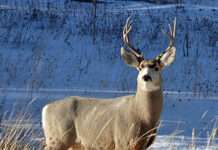Staring at the two deer mounts on our living room wall, and the fact that Kansas deer rifles season opens this week, brought back memories of the hunts when we harvested those two deer and also memories of the process of getting them mounted. Both deer came from ground farmed by my wife’s family in southwestern KS. The very nice nine-point whitetail was my wife’s first buck, and the dandy ten-point mule deer was my first big buck, so we decided to spend the money to have them both mounted. Immediately after we got home that year, I took both the heads to a taxidermist, thinking that was the end of our responsibility. Not so, and let me see if I can explain the process.
When a taxidermist receives an animal or fish, the first step is removing the skin so it can be tanned or processed. With deer, the meat processing plant or the hunter removes the head from the animal, along with the hide down past the shoulders; this hide is known as the “cape.” The head and the cape are then taken to the taxidermist. The taxidermist carefully skins out the head, removes the top of the skull with both antlers intact, tags and stores the antlers and sends the cape to be tanned. That tanned cape, with the corresponding antlers, is eventually fitted over a form made from a hard foam material. This form ultimately determines the “pose” of the finished mount. Note; if having you animal processed at a commercial processing plant, MAKE CERTAIN to tell them to cape-out the head so you have enough hide for the mount, otherwise they will cut the skin way too short for the taxidermist.
Next step is choosing how you want you deer head “posed.” I felt like I was at a portrait studio trying to choose final pictures for the church directory. Without thinking, I assumed our only choice was to have both deer looking away from the wall! Not so! There are four basic “poses” or positions, and several variations of each. They all center around the state of alertness you want the animal to replicate, and the direction you want it looking. The first of the four basic positions poses the head extremely low with ears laid back as if the buck were sneaking. The subsequent three each raise the head higher until the final basic view shows the deer on “full alert” and ready to bolt. The look we chose shows our bucks with upright heads, but not startled, and one looking each direction, as if at each other.
Another option to an expensive full-shoulder mount is simply having the antlers mounted on a nice plaque. Few taxidermists will do this anymore, but kits are available for you to do it yourself. In my office hangs a nice heavy set of antlers from a buck I found dead on our Ohio farm when I was a kid. A third option that has become very popular of late is called a “European Mount” which consists of the bare skull with the antlers attached. These can be decorated or painted for a unique look. A couple years ago I gave my sister a nice European Mounted rack from a buck I harvested on her property. Her home décor is western and southwest, so I mounted it on a weathered piece of barnwood and hung some old rusty barbed-wire on its antlers.
Here are some things to consider when deciding whether or not to have a fish or animal mounted. Trophies do not have to be determined by size alone. Unusual shapes and colors of fish and animals can make them memorable. The situation surrounding the catch or hunt may be worthy also, like a son’s first turkey, or in our case, my wife’s first buck, which was also harvested on her uncle’s land. Good quality pictures are very important too. Who knows, maybe a picture will be your trophy. A classy plaque sporting a good picture makes a very attractive memento.
The mount’s “final resting place” in your home should absolutely be defined and agreed upon by harvester and spouse. This issue has been the source of much conflict between mates over the years. Hopefully your significant other has their priorities right and sees it your way!
Cost is also a factor. While I realize a price cannot be put on everything, think reasonably. Shoulder mounts, which are the most popular are costing above $600 now. I found out many taxidermists no longer do simple antler mounts, but the one that do charge around $150, or you can buy the DYI kit for only a few bucks. There are a few guys around who do European mounts which will cost around $100.
Selecting which wildlife artist to trust with your prize is the final step. Recommendations from other sportsmen are probably the best litmus tests of all. Look at work done by those you’re considering, even visit them at their shops. They will gladly spend time with you, because they are fellow outdoorsmen and understand how important this decision is.
We didn’t choose to have our deer mounted merely to brag about them or our skills (although I could hardly wait for my brother to see them.) Each time we look at these awesome examples of God’s creation, we want to be able to close our eyes and watch again the scenes of the hunt unfold around us; to sense the exhilaration as we wait for each buck to give us just that “right” shot; to feel anew the pride and gratitude for the opportunity we had been given…Continue to Explore Kansas Outdoors!
Steve can be contacted by email at [email protected].





